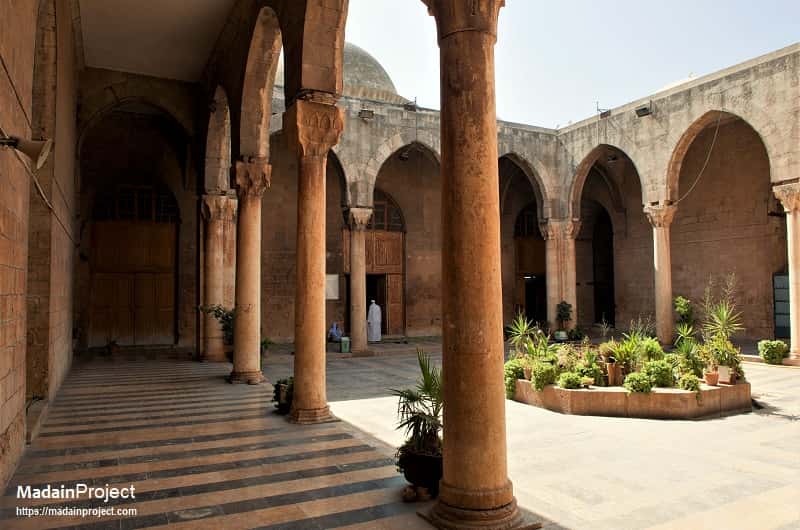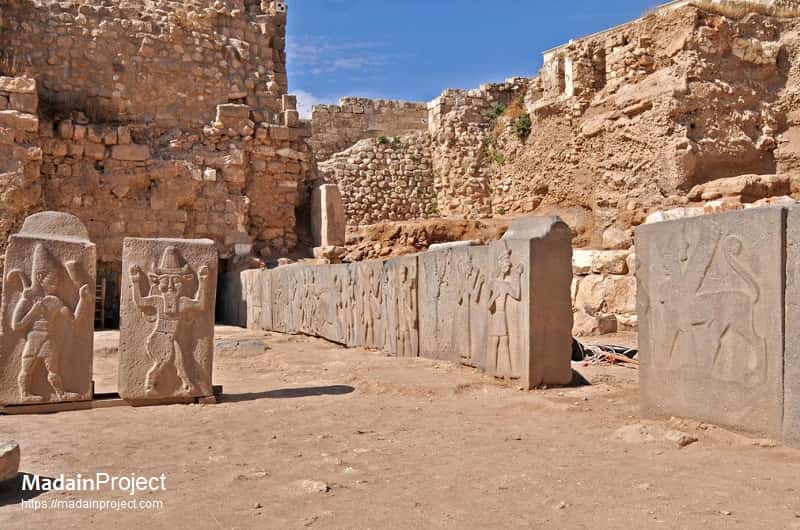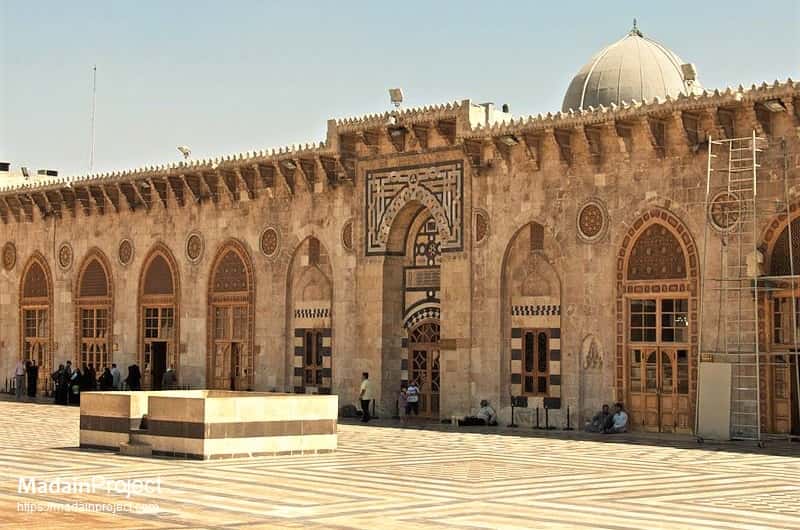Located at the crossroads of several trade routes from the 2nd millennium BCE, Ancient Aleppo was ruled successively by the Hittites, Assyrians, Arabs, Mongols, Mamelukes and Ottomans. It contains a lerge number of historical and archaeological sites dating back to different eras of its histoy. A 13th-century citadel, 12th-century Great Mosque and various 17th-century madrasas, palaces, caravanserais and hammams all form part of the city's cohesive, unique urban fabric. The old city of Aleppo reflects the rich and diverse cultures of its successive occupants. Many periods of history have left their influence in the architectural fabric of the city. Remains of Hittite, Hellenistic, Roman, Byzantine and Ayyubid structures and elements are incorporated in the massive surviving Citadel. Aleppo is an outstanding example of an Ayyubid 12th century CE city with its military fortifications constructed as its focal point following the success of Salah El-Din against the Crusaders.
Aleppo, one of the world's oldest continuously inhabited cities, boasts a history that stretches back over 4,000 years. Located in modern-day Syria, Aleppo's strategic position at the crossroads of several major trade routes, including the Silk Road, has made it a significant cultural, commercial, and political center throughout its history./p>
The origins of Aleppo can be traced to the early Bronze Age, around the 3rd millennium BC, when it was known as Halab. It emerged as a prominent city-state in the Amorite kingdom of Yamhad. Aleppo's early prominence was largely due to its strategic location, which facilitated trade and communication between Mesopotamia, the Levant, and Egypt. The city was known for its wealth and was a major hub for the trade of goods such as spices, textiles, and metals.
In the 2nd millennium BC, Aleppo came under the control of the Hittites, who recognized its strategic and economic importance. It later fell under the influence of the Mitanni, an ancient kingdom that controlled much of northern Syria and Mesopotamia. These transitions of power did not diminish Aleppo's significance; rather, they enhanced its role as a melting pot of cultures and a center of political power.
Aleppo continued to flourish during the Iron Age and became part of the Neo-Assyrian Empire in the 8th century BC. The city's significance persisted through subsequent empires, including the Neo-Babylonian and Persian Empires. During the Hellenistic period, following the conquests of Alexander the Great, Aleppo (then known as Beroea) was influenced by Greek culture and governance. It was later incorporated into the Roman Empire, continuing its role as a vital trade and cultural hub.
In the early centuries of the Common Era, Aleppo was part of the Byzantine Empire. The city saw substantial growth and development under Byzantine rule, serving as a crucial defensive and administrative center. With the advent of Islam in the 7th century, Aleppo was rapidly integrated into the Islamic world under the Rashidun, Umayyad, and Abbasid Caliphates. The city became a focal point of Islamic culture and learning, attracting scholars, traders, and pilgrims.
During the medieval period, Aleppo reached new heights of prosperity under the Ayyubid dynasty in the 12th century, led by the renowned Muslim leader Saladin. The Ayyubids fortified the city, constructing the formidable Citadel of Aleppo, which remains one of its most iconic landmarks. Aleppo also flourished under the Mamluks and later the Ottomans, who continued to invest in its infrastructure and commercial capabilities.
Aleppo became part of the Ottoman Empire in 1516 after the Ottomans defeated the Mamluks. Under Ottoman rule, the city thrived as a crucial hub along the Silk Road and other trade routes connecting Europe, Asia, and the Middle East. Its strategic location facilitated the trade of spices, textiles, and other goods, bolstering Aleppo's economic prosperity. The Ottomans invested in the city's infrastructure, building mosques, caravanserais, and public baths, which enriched its architectural landscape. Aleppo's thriving markets and skilled artisans contributed to its reputation as a center for textile production, particularly renowned for its silk and cotton fabrics.

The Great Mosque of Aleppo's Citadel, also known as Maqam Ibrahim, is located on the north side of the enclosure close to the retaining wall at one of the highest points on mound. In scholarship it is sometimes referred to as the "Upper Maqam Ibrahim," to distinguish it from the smaller mosque down the hill also dedicated to Abraham known as the Lower Maqam Ibrahim. Read more

Firdaws was founded in 1235 by Dayfa Khatun, daughter of Sultan al-Adil and the widow of Aleppo's ruler, al-Zahir Ghazi, the regent of Aleppo and a member of the Ayyubid dynasty. The madrasa is renowned for its elegant Islamic architecture. It features a large courtyard surrounded by arcades, classrooms, and living quarters for students and teachers. The madrasa building is adorned with intricate stone carvings, arabesques, and calligraphy. The mihrab (prayer niche) is particularly noted for its elaborate decoration. Read more

The Temple of the Storm-god Hadad in Aleppo is one of the oldest and most significant religious sites in the ancient Near East. Hadad, also known as Adad, was the storm-god worshipped in ancient Mesopotamian, Canaanite, and Syrian religions. He was associated with weather phenomena such as rain and thunderstorms, which were crucial for agriculture. The temple's architecture includes characteristic features of ancient Near Eastern religious structures, such as altars and courtyards. Read more
The Aleppo Codex, also called the "Crown of Aleppo" is the earliest known Hebrew manuscript comprising the full text of the Bible. The Codex was written in Tiberias in the early tenth century (circa 920 CE) under the rule of Abbasid Caliphs, looted and transferred to Egypt at the end of the eleventh century CE, and deposited with the Jewish community of Aleppo in Syria at the end of the fourteenth century CE. In January 1958 CE the Aleppo Codex was brought to Jerusalem, where it remains until today. Together with the Leningrad Codex (which dates to approximately the same time as the Aleppo codex), it contains the Ben-Asher masoretic tradition.
Explore

The Great Mosque of Aleppo, also known as the Umayyad Mosque of Aleppo, is one of the oldest and most significant mosques in Syria. Situated in the ancient city of Aleppo, close to the Aleppo Citadel, this historic mosque dates back to the early 8th century during the Umayyad Caliphate. Renowned for its architectural splendor and historical importance, the Great Mosque has served as a central place of worship, cultural hub, and symbol of Aleppo's rich heritage. Read more

The rich artistic tradition of the Jewish community of Aleppo is notable in its ceremonial objects which were donated by the members of the community to the synagogue to mark special occasions in their lives. The objects include Torah cases, crowns, elaborate silver finials, and oval plaques with dedicatory inscriptions. Similar plaques were also attached to the curtains (parokhot) in front of the Torah shrines. The inscriptions are fascinating historical documents, which reveal the personal stories of members of the community. Read more

The Citadel of Aleppo, a majestic fortress that dominates the skyline of Aleppo, Syria, is one of the oldest and largest castles in the world. Perched atop a hill in the center of the ancient city, the citadel's strategic location and impressive architecture reflect its historical significance and military importance over millennia. Dating back to the 3rd millennium BCE, it has been occupied and fortified by various civilizations, including the Greeks, Romans, Byzantines, and Ayyubids. Read more
The throne hall was the most important Mamluk architectural contribution to the Citadel of Aleppo. Even though it has not survived in its authentic state, it remains one of the most visited spaces in the historic citadel. Following the sack of the citadel by the conqueror Timur, known to the West as Tamerlane, in 1400s, the Mamluk governors of Aleppo embarked on a large-scale reconstruction program. During the restoration of the citadel a magnificent throne hall was added on top of the twelfth-century fortified entrance complex. The new throne hall was the grandest space in the citadel and it was used for official functions and for entertaining by the rulers of Aleppo and by Mamluk sultans visiting from Cairo. Damaged in a devastating earthquake that struck Aleppo in 1822 CE, the throne hall was heavily restored in the second half of the twentieth century and does not survive in its original form.
Explore

The Matbakh (kitchen) of al-'Ajami in Halab is situated approximately 150 meters west of the Aleppo Citadel, along a modern street linking the Citadel with the Great Mosque. Originally believed to be an Ayyubid palace constructed in the early 13th century CE by the prominent al-'Ajami family, it stands as the sole surviving non-royal Ayyubid palace in Syria. Its identification is supported by historical accounts, including Ibn Shaddad's reference to the nearby palace of Banu al-‘Ajami, associated with the construction of the Madrasa al-Sharafiyya. Read more
Signup for our monthly newsletter / online magazine.
No spam, we promise.